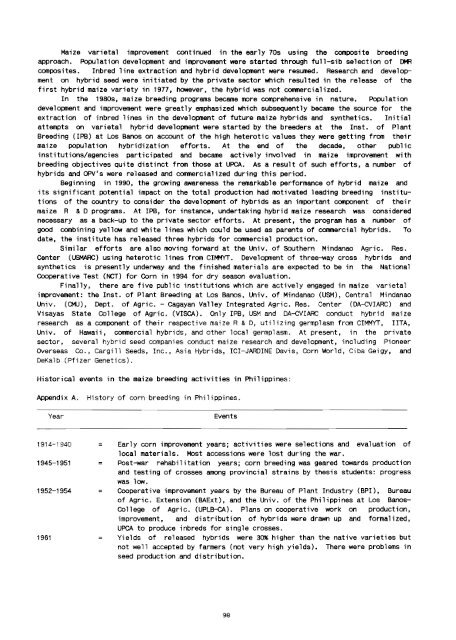Proceedings of the Fifth Asian Regional Maize Workshop - Search ...
Proceedings of the Fifth Asian Regional Maize Workshop - Search ...
Proceedings of the Fifth Asian Regional Maize Workshop - Search ...
Create successful ePaper yourself
Turn your PDF publications into a flip-book with our unique Google optimized e-Paper software.
<strong>Maize</strong> varietal improvement continued in <strong>the</strong> early 70s using <strong>the</strong> composite breeding<br />
approach. Population development and improvement were started through full-sib selection <strong>of</strong> DMR<br />
composites. Inbred line extraction and hybrid development were resumed. Research and development<br />
on hybrid seed were initiated by <strong>the</strong> private sector which resulted in <strong>the</strong> release <strong>of</strong> <strong>the</strong><br />
first hybrid maize variety in 1977, however, <strong>the</strong> hybrid was not commercialized.<br />
In <strong>the</strong> 198Os, maize breeding programs became more comprehensive in nature. Population<br />
development and improvement were greatly emphasized which subsequently became <strong>the</strong> source for <strong>the</strong><br />
extraction <strong>of</strong> inbred lines in <strong>the</strong> development <strong>of</strong> future maize hybrids and syn<strong>the</strong>tics. Initial<br />
attempts on varietal hybrid development were started by <strong>the</strong> breeders at <strong>the</strong> Inst. <strong>of</strong> Plant<br />
Breeding (IPS) at Los Banos on account <strong>of</strong> <strong>the</strong> high heterotic values <strong>the</strong>y were getting from <strong>the</strong>ir<br />
maize population hybridization efforts. At <strong>the</strong> end <strong>of</strong> <strong>the</strong> decade, o<strong>the</strong>r public<br />
institutions/agencies participated and became actively involved in maize improvement with<br />
breeding objectives quite distinct from those at UPCA. As a result <strong>of</strong> such efforts, a number <strong>of</strong><br />
hybrids and OPV's were released and commercialized during this period.<br />
Beginning in 1990, <strong>the</strong> growing awareness <strong>the</strong> remarkable performance <strong>of</strong> hybrid maize and<br />
its significant potential impact on <strong>the</strong> total production had motivated leading breeding institutions<br />
<strong>of</strong> <strong>the</strong> country to consider <strong>the</strong> development <strong>of</strong> hybrids as an important component <strong>of</strong> <strong>the</strong>ir<br />
maize R&D programs. At IPB, for instance, undertaking hybrid maize research was considered<br />
necessary as a back-up to <strong>the</strong> private sector efforts. At present, <strong>the</strong> program has a number <strong>of</strong><br />
good combining yellow and white lines which could be used as parents <strong>of</strong> commercial hybrids. To<br />
date, <strong>the</strong> institute has released three hybrids for commercial production.<br />
Similar efforts are also moVing forward at <strong>the</strong> Univ. <strong>of</strong> Sou<strong>the</strong>rn Mindanao Agric. Res.<br />
Center (USMARC) using heterotic lines from CIMMYT. Development <strong>of</strong> three-way cross hybrids and<br />
syn<strong>the</strong>tics is presently underway and <strong>the</strong> finished materials are expected to be in <strong>the</strong> National<br />
Cooperative Test (NCT) for Corn in 1994 for dry season evaluation.<br />
Finally, <strong>the</strong>re are five public institutions which are actively engaged in maize varietal<br />
improvement: <strong>the</strong> Inst. <strong>of</strong> Plant Breeding at Los Banos, Univ. <strong>of</strong> Mindanao (USM) , Central Mindanao<br />
Univ. (CMU) , Dept. <strong>of</strong> Agric. - Cagayan Valley Integrated Agric. Res. Center (DA-CVIARC) and<br />
Visayas State College <strong>of</strong> Agric. (VISCA). Only IPS, USM and DA-eVIARC conduct hybrid maize<br />
research as a component <strong>of</strong> <strong>the</strong>ir respective maize R & D J utilizing germplasm from CIMMYT, IITA,<br />
Univ. <strong>of</strong> Hawaii, commercial hybrids, and o<strong>the</strong>r local germplasm. At present, in <strong>the</strong> private<br />
sector, several hybrid seed companies conduct maize research and development, including Pioneer<br />
Overseas Co., Cargill Seeds, Inc., Asia Hybrids, leI-JARDINE Davis, Corn World, Ciba Geigy, and<br />
DeKalb (Pfizer Genetics).<br />
Historical events in <strong>the</strong> maize breeding activities in Philippines:<br />
Appendix A.<br />
Year<br />
History <strong>of</strong> corn breeding in Philippines.<br />
Events<br />
1914-1940<br />
1945-1951<br />
1952-1954<br />
1961<br />
=<br />
=<br />
=<br />
Early corn improvement years; activities were selections and evaluation <strong>of</strong><br />
local materials. Most accessions were lost during <strong>the</strong> war.<br />
Post-war rehabilitation years; corn breeding was geared towards production<br />
and testing <strong>of</strong> crosses among provincial strains by <strong>the</strong>sis students: progress<br />
was low.<br />
Cooperative improvement years by <strong>the</strong> Bureau <strong>of</strong> Plant Industry (BPI), Bureau<br />
<strong>of</strong> Agric. Extension (BAExt), and <strong>the</strong> Univ. <strong>of</strong> <strong>the</strong> Philippines at Los Banos<br />
College <strong>of</strong> Agric. (UPLB-eA). Plans on cooperative work on production,<br />
improvement, and distribution <strong>of</strong> hybrids were drawn up and formalized,<br />
UPCA to produce inbreds for single crosses.<br />
Yields <strong>of</strong> released hybrids were 30% higher than <strong>the</strong> native varieties but<br />
not well accepted by farmers (not very high yields). There were problems in<br />
seed production and distribution.<br />
98

















